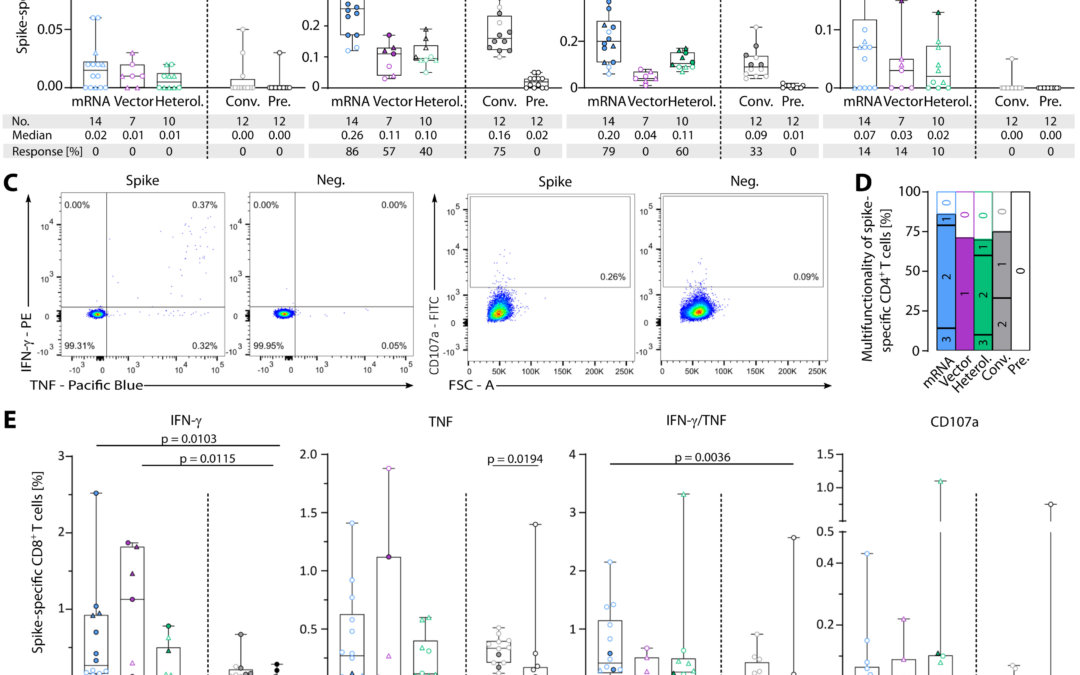November 9, 2022
In a recent article from November 1 in Science Immunology, the authors reported on their analysis of T-cell immunity four weeks and six months after different vaccination regimens and four weeks after an additional booster vaccination. This was a prospective cohort study started in 2021 located in Germany in which they compared those with complete vaccination and boostering to those who were convalescent and pre-pandemic donors. People in the population had received any of these or a combination due to boostering (BNT162b2, mRNA-1273, ChAdOx1, or Ad26.COV2.S), better known as Pfizer, Moderna, AstraZeneca, or Johnson-Johnson. They measured T-cell responses against the whole spike protein and also against the Omicron Ba.1 and Ba.2 variant mutations. The study did not have randomization nor blinding, since that was not feasible.
The authors report in their statistical analysis section that they analyzed everything in GraphPad Prism 9.2.0. They analyzed continuous outcomes, depending up on the assumption of normality by using either a two-sided Fisher’s exact test, unpaired t-test, unpaired Mann-Whitney-U-test, Kruskal-Wallis test, or paired Wilcoxon signed rank test and Friedman test. This we have seen amongst their many graphs of various assays run from lab data that they used one or more of these procedures as the p-values are listed in their graphs. They said that correlation was tested using Spearman test, but they did not state what outcome was rank ordered and have just assumed Spearmann rank-correlation is for any non-parametric outcome, and linear regression. They stayed with a convention p-value of <0.05 were considered statistically significant.
The results from their graphs are hard to read but most of the plots are of the IFN-gamma T=cell responses. They found that intensity of spike-specific T-cell responses did not significantly differ between the three vaccination cohorts and convalescent donors, but they did find that mRNA- and heterologous-vaccinated donors exhibited a two to three-fold increased T-cell response intensity when compared to vector-vaccinated and convalescent donors. They found no correlation between the time point of sample collection after complete vaccination, demographic donor characteristics comprising body mass index (BMI), age, sex or side effects after vaccination as well as clinical symptoms of COVID-19 (as assessed by questionnaires) of complete vaccination and convalescent individuals, respectively, and the intensity of spike-specific IFN-γ T-cell responses.
To summarize their findings, they found that the T-cell responses they measured through their various assays remained stable over time following complete vaccination but with no significant effect of booster vaccination on T-cell responses as well as cross-recognition of Omicron BA.1 and BA.2 variants. They then further state that their work shows that different vaccination regimens induce broad and long-lasting spike-specific CD4+ and CD8+ T-cell immunity to SARS-CoV-2.
Written by,
Usha Govindarajulu
Keywords: COVID-19, vaccination, T-cell responses, booster vaccination
References
Maringer V, Nelde A, Schroeder SM, Schuhmacher J, Hörber S, Peter A, Karbach J, Jager E, and Walz JS. (2022). “Durable spike-specific T-cell responses after different COVID-19 vaccination regimens are not further enhanced by booster vaccination”. Science Immunology. https://www.science.org/doi/10.1126/sciimmunol.add3899
